How To Draw Images For Website Publishing
Pictures have power on the page — the ability to catch your readers' attending and to convey or enhance your message. Pictures aid readers find entry points into the text. They give readers a quick summary of what the text is about and help grasp circuitous ideas.
Pictures can relieve the tedium of grey type. But they can also distract from your message if pictures don't relate closely to the message. Make sure you control your bulletin with the pictures in your publication.
What do you want to practice?
-
Heighten your message with pictures
-
Use the right size picture for the medium
-
Reduce the size of your publication by using linked pictures
-
Acquire pictures you tin use
-
Refine the pictures y'all learn
Raise your message with pictures
When you create or select images for a publication, make them:
-
Relevant Use pictures to clarify central concepts. Considering readers skim pages by reading headlines and picture captions, you can help readers glean your most important messages past reinforcing letters with pictures and brief descriptions.
-
Consistent Unify your publication with your choice or treatment of pictures. Y'all tin give pictures a consistent expect in several means. For example, you can use a small palette of colors or a unmarried accent color, a common graphic style, the aforementioned camera bending or betoken of view, or consistent lighting. You can as well apply the same filter effects to each epitome, or you lot can use the same human models in a progressing story line.
-
Homo Most people like to await at other people. Portraits of people will draw readers' attending, particularly if the images are relevant and tell a story. Past using images to show someone using your product or service, you aid readers to see how it works and to envision themselves using it.
-
Motionless Animation grabs the centre and doesn't let it go. Gratuitous animation risks stopping your potential customers in their tracks — they may become so distracted that they miss the indicate. If you utilize an animated picture in an online publication, give it a clear purpose (for instance, testify a sequence of your production in apply).
Apply the right size movie for the medium
Y'all tin can change the size and resolution of graphics—unremarkably with good results. Merely sometimes a graphic tin't be reduced or enlarged enough to fit your needs. That's why it is skillful to know what you need before you start and observe the all-time lucifer.
Graphics created past a paint program, a scanning program, or a digital camera are made up of a grid of differently colored squares called pixels. A motion-picture show contains the same amount of information, or number of pixels, whether you calibration it larger or smaller in your publication.
The resolution of a picture show is expressed in pixels per inch (ppi) or dots per inch (dpi). These terms are oft used interchangeably.
If you want more details to appear every bit you lot overstate your picture, you need to start with a motion-picture show that has more than pixels, or a higher constructive resolution. Enlarging a picture decreases the resolution (fewer ppi). Reducing the dimensions of a picture increases its resolution (more ppi).
If your pic resolution is too depression, the picture volition have a blocky, or pixilated, appearance. If the picture resolution is besides high, the file size of the publication becomes unnecessarily large, and it takes more time to open, edit, and print it. Pictures with a resolution higher than 1,000 ppi may not print at all.
Find the constructive resolution
Every pic in your publication has an effective resolution that takes into account the original resolution of the graphic and the effect of scaling it in Publisher. For example, a picture with an original resolution of 300 ppi that has been scaled 200 pct larger has an effective resolution of 150 ppi.
To observe the effective resolution of a picture in your publication, exercise the following:
-
Click Tools > Graphics Manager.
-
In the Graphics Director chore pane, nether Select a picture show, click the arrow side by side to the picture with the info you want, and so click Details.
-
The Effective Resolution field displays the resolution in dots per inch (dpi).
If you lot plan to have color pictures printed by a commercial printer, your picture resolution should exist between 200 ppi and 300 ppi. You tin have a higher resolution — upward to 800 ppi — but you lot should not have a lower resolution. If you plan to employ the pictures online only (on the Web or in PowerPoint, for case), the pictures demand to accept a resolution of only 96 ppi, which is the screen resolution of figurer monitors.
File format can likewise affect file size. Before you change the resolution of your flick, make sure you use a file format that is appropriate for the content of the prototype. The following tabular array lists common moving picture file formats, their uses, and their advantages.
| File format | Online | Desktop press | Commercial printing | Primary uses | Characteristics |
| BMP | x | x | Line art (icons, buttons, logos) | Small file size, few colors, no transparency, little pinch | |
| EMF | 10 | 10 | Line art | Comeback on BMP, with smaller file size | |
| EPS | ten | 10 | Line art, art with clipping paths, duotones, spot colors | CMYK color data | |
| GIF | ten | Depression-resolution, flat-color, sharp-edged line art (icons, buttons, logos), animations | Small file size, few colors, transparency, some compression with no loss of detail | ||
| JPEG | 10 | ten | Photos | Small file size, millions of colors, no transparency, flexible compression with loss of particular | |
| PNG | x | x | x | Line fine art, animation | Improvement on GIF, with smaller file size, millions of colors, transparency, and compression without loss of detail |
| TIFF | 10 | 10 | Photos, line art | Large file size, rich RGB and CMYK colour data, transparency, compression without loss of detail | |
| WMF | x | ten | Line art | Improvement on BMP, with smaller file size |
Reducing high-resolution graphics
If you have just a few graphics with a resolution that'south too high, y'all'll probably withal be able to print them without an issue. If you have several high-resolution graphics, your publication will impress more efficiently if you reduce their resolution by compressing them.
Before you compress a film, determine its size on the page. When you compress a moving-picture show in Publisher, information technology loses detail, and enlarging it later volition lower its quality. You tin reduce the dimensions of a compressed motion-picture show further without a loss in quality. If you do so, compress it over again to remove additional unneeded image data.
Of import:Before y'all reduce the resolution of a graphic that you intend to include in a publication that will exist printed by a commercial printer, you should consult with your commercial printing service. They'll be able to tell you exactly what resolution you need.
Reduce high-resolution graphics
In Publisher, you can reduce the resolution of one, several, or all pictures by compressing them.
-
Right-click a picture show, click Format Picture > Picture.
-
Click Compress.
-
In the Compress Pictures dialog box, nether Target Output, practise i of the post-obit:
-
Click Commercial press to compress the pictures to 300 pixels per inch (ppi).
-
Click Desktop Printing to shrink the pictures to 220 ppi.
-
Click Web to compress the pictures to 96 ppi.
-
-
Under Use compression settings now, cull whether you want to shrink all pictures in the publication or but the pictures that you selected, then click OK.
-
If a message appears request whether you want to use moving picture optimization, click Yeah.
A compressed version of the same pic or pictures replaces the original high-resolution picture show or pictures.
Reduce the size of your publication past using linked pictures
Each fourth dimension you insert a picture in your publication, the publication grows in size. By linking to the pictures instead, you can avert a large file size acquired by embedded graphics.
When you lot link to pictures, any subsequent changes that are made to the prototype files will exist reflected in the pictures in your publication.
Note:If yous move your publication to a different estimator, make sure y'all motion copies of the linked pictures too. When you apply the Pack and Go Wizard, this step is done for you.
Insert a picture equally a link
-
Click Insert > Picture > From File.
-
In the Insert Picture dialog box, browse to notice the movie that yous want, and and so select it.
-
Click the arrow next to Insert, and so click Link to File.
Learn pictures yous tin use
With good ideas, a good middle, and good equipment, you can take your ain pictures or hire someone to take them.
If you lot don't have the power to create professional-quality photos or illustrations, wait for pictures at a variety of online sources, including:
-
Bing, which you tin can apply without leaving Role. In Function 2013 or 2016 become to Insert > Online Pictures. In older versions of Office, become to Insert > Clip Art.
-
Stock photo companies, such equally Corbis and Getty (payment required).
-
Other search engines, such every bit MSN, Yahoo, and Google (usage rights vary).
-
Libraries and other public institutions, such as the Library of Congress (usage rights vary).
Legal issues
The wide availability of images online makes it tempting to re-create and reuse a picture from the web without explicit permission or payment. Avoid copyright infringement action by making sure that you take the right to use an image before you lot publish it.
When using pictures or clip art from Bing, you lot're responsible for respecting copyright, and the license filter in Bing tin assist you choose which images to use.
When you buy stock photography, you purchase the rights to use information technology for a variety of purposes. Most pictures and stock photography can't be used for resale; that is, you tin can use it to promote your business organization, just you cannot use it equally the product itself.
If you take any doubts about using an image, contact the source possessor and inquire for permission before y'all publish it.
Refine the pictures you acquire
You can alter and enhance your pictures so that your publications have the unique expect or character that suits your customers and your business. Although you lot can use a photo-editing program to create a near limitless number of changes, you can use the drawing tools in Publisher to make refinements to a picture show, including the following:
-
Cropping
-
Resizing
-
Rotating and flipping
-
Adding a drop shadow
-
Changing contrast and brightness
-
Wrapping the text around a clip
When you lot use effects, you can give your publication a consistent appearance past applying the effect to all pictures in your publication.
Tip:After y'all modify a clip, you may desire to salvage it so that you can use it once again. To save a modified prune, correct-click it, and then click Salvage as Picture. In the Save Every bit dialog box, in the Relieve as type list, click a file format. If you program to use the modified clip in print publications, save information technology in Microsoft Windows Metafile (.wmf) format. If yous plan to apply the clip in Web publications, click Change, so click Web (96 dpi). Save the prune in Graphics Interchange Format (.gif). Click a location in Save in, and and then click Save.
Cropping
When you crop an paradigm, you're removing areas that y'all don't want to be shown. In this example, all but the lower-correct portion of the big image was cropped to focus tightly on the masks. The result is shown in the smallest image.
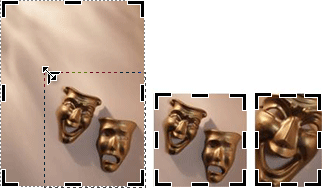
-
Select the clip in your document.
-
Click Movie > Crop
 .
. -
Identify the pointer over 1 of the black ingather handles along the edge of the clip. Then click and drag until you have cropped the prune to the area that you want.
Resizing
When you find the perfect clip for your document, information technology might not be the right size. Because cropping isn't always appropriate, you can enlarge or reduce the prune and so that information technology fits within a sure area. For instance, the outset prune below was reduced to the second clip.
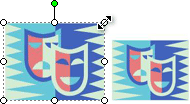
-
Select the clip.
-
Motion your pointer over 1 of the open circles at a corner of the image.
-
Drag until the prototype is the size that y'all desire.
Annotation:Dragging an open circumvolve at a corner resizes the prototype proportionally. If you elevate one of the side circles, the image grows or shrinks disproportionately, every bit shown hither.
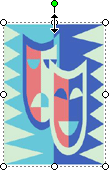
Rotating and flipping
Rotating a clip can enhance a page design by calculation a dynamic asymmetry. For case, this mask in its vertical orientation is static and predictable. Rotated slightly, the mask gives the impression of movement (without the distraction of animation).
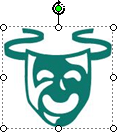
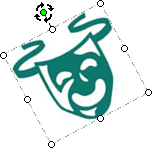
Flipping a clip can provide symmetrical rest to the page. This pair of performers is created by copying the clip on the left and flipping its pasted duplicate on the right. They might serve equally bookends for an important headline.

Rotate a clip
-
Select the clip.
-
Click Adjust > Rotate or Flip, and then exercise 1 of the following:
-
Click Rotate Left ninety° or Rotate Right xc° to rotate the prune in 90-degree increments. Click once to rotate the clip 90 degrees. Keep to click until the clip is in the position that yous want.
-
Click Free Rotate, and then identify the pointer over the round green handle at the peak of the object. When yous run across a circumvolve around the green handle, elevate until the object is at the angle that you desire.
-
Flip a clip
-
Select the prune.
-
Click Conform > Rotate or Flip, and then click Flip Horizontal or Flip Vertical.
Adding a drop shadow
Calculation a drib shadow to a prune can requite dimension and depth to your publication, and it can provide a professional appearance.
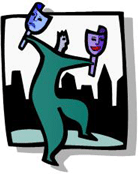
-
Select the clip.
-
Click Formatting > Shadow Mode
 , and select the style you lot want.
, and select the style you lot want.
Notation:To remove a drop shadow, click Shadow Style and then select No Shadow.
Changing contrast and effulgence
You can modify the appearance of a prune by adjusting the contrast and effulgence of the epitome.
-
Select the clip.
-
On the Flick toolbar, do whatever of the following:
-
To increment the brightness, click More than Brightness
 .
. -
To reduce the brightness, click Less Brightness
 .
. -
To increase the dissimilarity, click More Contrast
 .
. -
To reduce the contrast, click Less Dissimilarity
 .
.
-
Arrange the levels and compare the differences. For example, you lot can make a clip darker past decreasing the effulgence, or you can subdue it past reducing the contrast.
If you want to place the clip behind text, you tin launder out the clip by clicking Picture > Color  , and then selecting the Washout option.
, and then selecting the Washout option.
Wrapping the text around a clip
One way to add a professional look is to add together text that wraps around an epitome. The Text Wrapping feature lets you lot place a prune amid blocks of text.
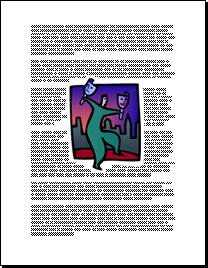
-
Insert the clip in a cake of text.
-
With the prune selected, click Picture > Text Wrapping
 , and so click the way of text wrapping that you want to add.
, and so click the way of text wrapping that you want to add.You can wrap text around, over and under, or through a motion-picture show. You also can choose to edit the wrap points, which can be useful with irregular shapes.
Tip:You tin place the graphic in your certificate either earlier or subsequently yous add together the text, but it may exist easier to position the graphic with a text wrap afterwards all of the text is in the document.
Source: https://support.microsoft.com/en-us/office/tips-for-working-with-images-in-publisher-2edbdb84-e56a-43d9-b16c-090c38970c8b
Posted by: blanchtuadve2002.blogspot.com


0 Response to "How To Draw Images For Website Publishing"
Post a Comment